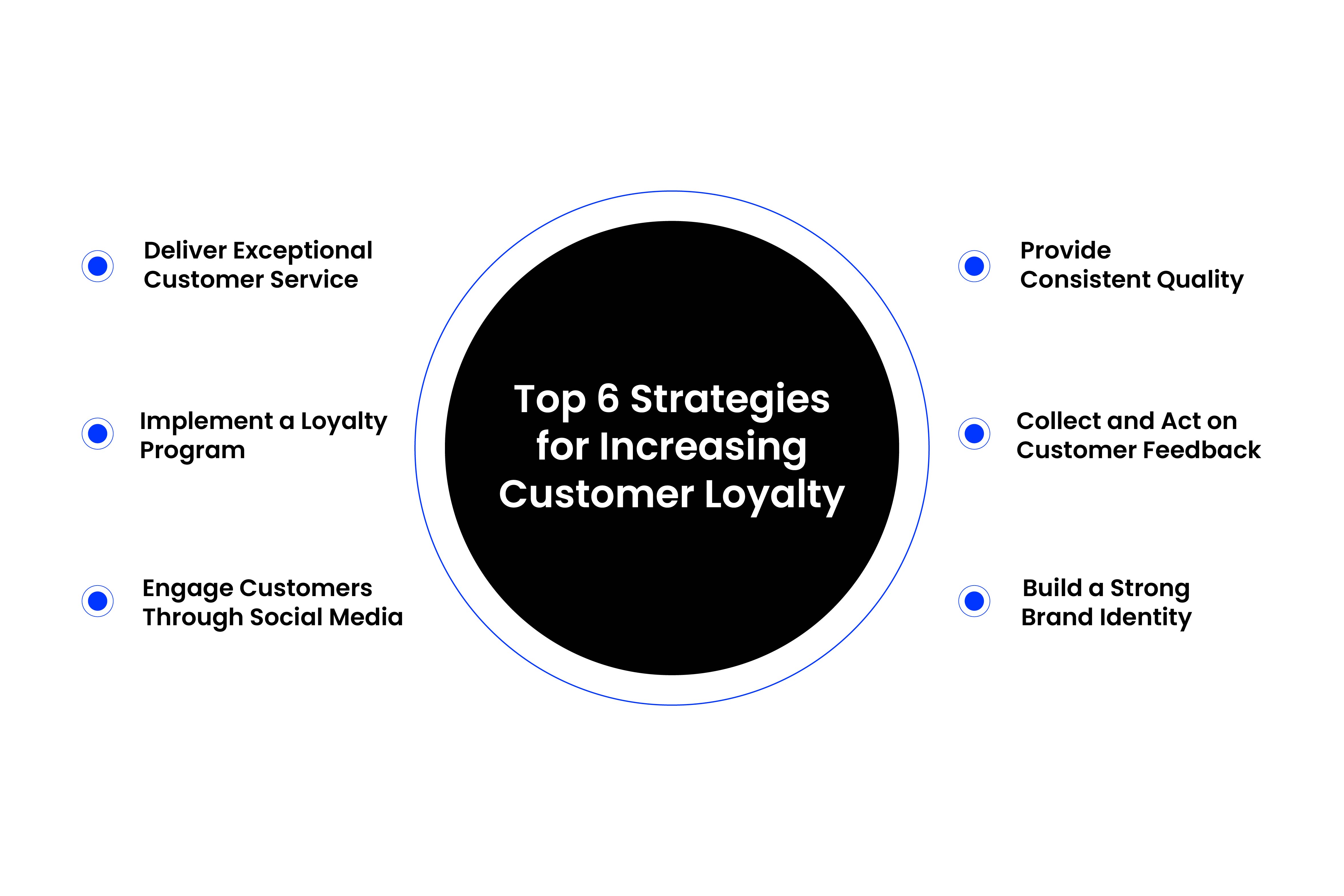Top 6 Strategies for Increasing Customer Loyalty
- Reading Time: 8 minutes
Maintaining a loyal customer base is essential for long-term business success. Recent research shows that loyal customers spend 67 percent more on average than those new to your business. This makes loyalty not just a goal, but a powerful driver of long-term profitability.
To build such loyalty, companies need to go beyond traditional methods and embrace data-driven strategies. By leveraging Dataroid, businesses can gain deep insights into customer behavior, enabling them to create personalized experiences that resonate with their audience. These insights allow companies to identify what truly drives loyalty and implement targeted actions that reinforce customer commitment, leading to stronger, more profitable relationships.
The top 6 strategies for increasing customer loyalty are listed below.
- Deliver exceptional customer experience: Ensure prompt, personalized, and effective customer support.
- Implement a loyalty program: Reward repeat customers with points, discounts, or exclusive offers.
- Engage customers through social media: Build a community by sharing valuable content and interacting with followers.
- Provide consistent quality: Maintain high standards in product and service quality to build trust.
- Collect and act on feedback: Regularly gather customer feedback and use it to make improvements.
- Build a strong brand identity: Create a memorable and consistent brand that resonates with your audience.

Understanding Customer Loyalty
Customer loyalty refers to a customer’s willingness to repeatedly purchase from a specific brand due to positive experiences and satisfaction. Loyal customers are not only repeat users but also brand advocates who recommend your products or services to others.
Loyalty is built over time through consistent positive interactions. It is not just about repeat purchases but also about emotional connections and trust. When customers feel valued and appreciated, they are more likely to stick with your brand even when competitors try to lure them away with lower prices or enticing offers.

Best 6 Strategies to Boost Customer Loyalty
These six strategies focus on delivering exceptional customer experiences, building emotional connections, and leveraging data to refine and personalize interactions. By integrating these approaches, businesses can significantly enhance customer retention and foster brand loyalty.
Strategy 1: Deliver Exceptional Customer Experience
The most direct cause of customer loyalty is exceptional customer experience. Customers are more likely to stay loyal to brands that value them and address their needs promptly. Exceptional customer experience can turn a casual visitor into a lifelong customer. It is the human touchpoint that often makes the difference, as customers remember how they were treated more than the product they bought.
How to Improve Customer Experience
- Train your team: Ensure your customer success team is well-trained and knowledgeable about your products or services. Regular training sessions can keep the team updated on new features and best practices.
- Be responsive: Quick and effective responses to customer inquiries can make a significant difference. Use automated systems to acknowledge receipt and follow up with personalized solutions.
- Personalize engagement: Use customer behavioral data to personalize your interactions and make customers feel valued. Personalized marketing offers can show customers that you understand their needs.
- Gather feedback: Regularly seek customer feedback on their service experience and use it to make improvements. This shows customers that you are committed to their satisfaction.
Strategy 2: Implement a Loyalty Program
Loyalty programs are an effective way to reward repeat customers and incentivize future purchases. These programs can include points systems, discounts, exclusive offers, or early access to new products.
Loyalty programs not only encourage repeat business but also provide valuable data on customer preferences and behaviors. This data can be used to tailor marketing efforts and create more personalized customer experiences. Additionally, a well-designed loyalty program can create a sense of belonging among customers, fostering a deeper connection to your brand.
4 Types of Loyalty Programs
- Points-based programs: Customers earn points for every purchase, which can be redeemed for rewards. This type of program is straightforward and easy for customers to understand.
- Tiered programs: Customers unlock different benefits as they reach higher spending levels. This can motivate customers to spend more to reach the next tier.
- Subscription programs: Customers pay a recurring fee for exclusive benefits, such as free shipping or special discounts. Subscription models can provide a steady revenue stream and ensure consistent engagement.
- Referral programs: Encourage your existing customers to refer new customers to your business by offering rewards for successful referrals. This taps into word-of-mouth marketing and can expand your customer base.
Strategy 3: Engage Customers Through Social Media
Social media platforms provide a unique opportunity to engage with customers and build a community around your brand. According to a study by Sprout Social, 75% of consumers have purchased a product because they saw it on social media.
Social media allows for real-time interaction and engagement. It is a platform where brands can show their human side, share stories, and build deeper relationships with their audience. By consistently posting valuable content and responding to customer interactions, brands can foster loyalty and create a vibrant online community.
4 Tips for Effective Social Media Engagement
- Create valuable content: Share informative and entertaining content that resonates with your audience. Use a mix of posts, including videos, infographics, and stories, to keep your feed dynamic.
- Respond to comments and messages: Show your customers that you value their opinions and feedback. Prompt and thoughtful responses can turn a casual follower into a loyal fan.
- Run social media campaigns: Host contests, giveaways, or challenges to encourage participation and foster a sense of community. These activities not only engage your existing audience but can also attract new followers.
- Use influencers: Partner with influencers who align with your brand values to reach a broader audience. Influencers can provide authentic endorsements that resonate with their followers.
Sign up to drive your business with the power of data
Strategy 4: Provide Consistent Quality
Consistency in product quality and service is crucial for building trust and loyalty. Customers expect the same high standards every time they interact with your brand.
When customers know they can rely on your brand for consistent quality, they are less likely to look elsewhere. Consistency reinforces brand reliability and builds trust. It also simplifies decision-making for customers, as they do not need to weigh the risks of fluctuating quality.
How to Maintain Consistency
- Standardize processes: Implement standard operating procedures (SOPs) to ensure uniformity in product quality and customer experience. Documented processes help maintain consistency across different teams and locations.
- Monitor feedback: Regularly review customer feedback to identify areas for improvement. Use this feedback to make continuous enhancements and address any inconsistencies.
- Invest in quality control: Allocate resources to quality control measures to prevent defects and maintain high standards. Regular audits and quality checks can help catch issues before they reach the customer.
- Train your staff: Regular training ensures that all team members are aligned with the brand’s quality standards and know how to maintain them.
Strategy 5: Collect and Act on Customer Feedback
Customer feedback is invaluable for understanding customer needs and improving your offerings. By actively seeking and acting on feedback, you show customers that their opinions matter.
Listening to customer feedback can reveal pain points and opportunities for innovation. It can also help you identify trends and shifts in customer preferences, allowing you to stay ahead of the competition. Acting on feedback demonstrates to customers that you are committed to continuous improvement and their satisfaction.
Methods for Collecting Feedback
- Surveys: Use online surveys to gather customer opinions on various aspects of your business.
- Reviews: Encourage customers to leave reviews on your website or social media pages. Positive reviews can also act as testimonials for potential customers.
- Direct communication: Reach out to customers via email or phone to ask for their feedback. Personal touchpoints can provide more in-depth insights and build stronger relationships.
- Feedback forms: Include feedback forms in your product packaging or at the point of sale to capture real-time customer opinions.
Strategy 6: Build a Strong Brand Identity
A strong brand identity helps differentiate your business from competitors and fosters a sense of loyalty among customers. Your brand identity encompasses your logo, colors, messaging, and overall customer experience.
A well-defined brand identity creates a cohesive and memorable brand image. It helps customers understand what your brand stands for and what they can expect from it. Consistent branding across all touchpoints builds recognition and trust, making customers more likely to return.
4 Steps to Build a Strong Brand Identity
- Define your brand values: Clearly articulate what your brand stands for and communicate these values consistently. Your values should resonate with your target audience and differentiate you from competitors.
- Create a memorable logo and design: Invest in professional design to create a visually appealing and recognizable brand. Your logo and design elements should reflect your brand’s personality and values.
- Ensure consistency across all channels: Maintain a consistent brand voice and visual identity across all digital channels. This includes your website, mobile app, social media, packaging, and advertising materials.
- Engage in storytelling: Share your brand’s story and mission to create an emotional connection with your audience. Authentic stories can resonate deeply and build lasting loyalty.
Leveraging Dataroid for Customer Loyalty
To maximize the effectiveness of your customer loyalty strategies, consider integrating Dataroid into your approach. Dataroid offers a range of features that can help you better understand your customers and tailor your efforts to meet their specific needs.
With Dataroid, business can:
- Gain Customer Insights: Leverage Dataroid’s analytics to understand customer behaviors and preferences, enabling more effective customer segmentation and personalized experiences.
- Personalize Interactions: Use Dataroid to create tailored customer experiences, increasing engagement and loyalty.
- Predict Customer Churn: Identify at-risk customers with predictive analytics and implement targeted strategies to reduce churn and retain loyal customers.
Take your customer loyalty to the next level with Dataroid—start leveraging data-driven insights today to build stronger, more lasting relationships with your customers. Contact us now to learn how.
Frequently Asked Questions
What is the most effective way to increase customer loyalty?
The most effective way to increase customer loyalty is by delivering exceptional customer experience, creating personalized experiences, and maintaining consistent product quality. Implementing a well-designed loyalty program and engaging customers through social media also play crucial roles.
How to use social media for customer loyalty
Social media offers a platform to connect with your customers in real time, share valuable content, and build a strong community around your brand. Regular engagement on social media can deepen customer loyalty and create brand advocates.
How important is customer feedback?
Customer feedback is crucial for understanding what your customers value and where improvements are needed. By actively responding to feedback, you demonstrate a commitment to customer satisfaction, which strengthens loyalty.
How does customer loyalty differ across industries?
Customer loyalty varies across industries due to differences in customer expectations and the nature of products or services; for example, in retail, loyalty is driven by price and convenience, while in healthcare, it’s built on trust and quality of care. Tailoring strategies to these specific industry factors is crucial for fostering loyalty.

YOU MAY ALSO LIKE
User Path Analysis: How to Understand and Improve Your Customer Journey
What is User Segmentation? A Complete Guide to Targeting Your Audience
How to Perform Customer Behavioral Segmentation in 5 Steps
The Importance of Event Tracking in Banking
Enhance Personalized Banking Offers with Behavioral Insights
Drive your digital growth
Schedule a demo today to learn more on how we can help you unleash the potential of digital using Dataroid.




